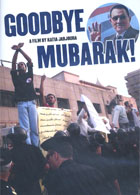
Goodbye Mubarak 2011
Distributed by Icarus Films, 32 Court St., 21st Floor, Brooklyn, NY 11201; 800-876-1710
Produced by Amip – ARTE France
Directed by Katia Jarjoura
DVD, color, 72 min.
Jr. High - General Adult
Social Movement and Collective Behavior, Protest, Revolt and Revolution, Human Rights, Political Science and Politics, Activism, Middle East, Egypt, Arab Spring, Government and Repressive Regimes
Date Entered: 06/04/2012
Reviewed by Malcolm L. Rigsby, Department of Sociology and Human Services, Henderson State University, Arkadelphia, ArkansasFilm shot with this quality creates a desire to become part of the material being portrayed. Director Katia Jarjoura takes us on a trip that she began in October 2010. We arrive on the eve of planned elections. However, it is clear that journalism and media coverage is sidetracked from reporting the concerns of all parties and the candidates. More particularly, we see that the people are overwhelmed by deep despair built upon long-term frustrations over poverty and social inequality. Jarjoura integrates her coverage with historical context surrounding the presidency of Hosni Mubarak including the tense 2005 election. The portrait painted by Jarjoura is of a society on the brink of “tilt.” Like a teeter-totter, the disorganized society delicately balances between mundane and extra-ordinary collective action.
The film depicts a view of the collective response of people to a non-responsive government. Scenes are realistically shot from the street and often we see minor and serious confrontations between the people and the regime’s authorities. It has been said that organization and mobilization of collective events such as revolt and revolution is hard to study and predict because each type of action has an individual character. Often what media covers and labels revolution is nothing more than protest, or at most revolt. In the case of Egypt, we see the merging of several collective events that mature into true collective action. Through stages of dissatisfaction fraught with fear of authorities we see revolt arise and eventually the overthrow of the regime. Was this event more than revolt, and if so did it constitute a complete revolution? Students will find this film a fascinating opportunity to analyze theoretical concepts of collective behavior, collective action, and social movement as they attempt to determine whether the January events of 2011 were true revolution or political revolt. On a broader scale, the film will provide an excellent opportunity to evaluate the events in Egypt and compare to those that have escalated and migrated to other nations such as Libya and to Syria.
More than comparative study of revolt and revolution the film offers an excellent examination of one way in which the people organized and mobilized collective action. We see the use of conventional methods such as street meetings, dialogue with citizens, and brochures, but we also note the creative use of media such as the Internet. One component of mobilization relates to how filmmakers as activists, as opposed to recorders of events, may play vital roles in how collective action and other events may gain the awareness of the public and may serve as alternative channels of communication when the people of a nation can no longer respect or trust the official channels of news. Documentary filmmakers may provide necessary momentum for public opinion to tilt both politically and socially toward open demonstration, revolt, or revolution within a nation’s people, while conversely they may prop up and support a nation’s governmental authority.
The narration accompanying this film is superb and very easy to follow. Transition between scenes, interviews, and film archives are smooth. Sound, picture quality and scenes are vivid and alive. The film offers an excellent point of departure for class and group discussion.
For a preview, please watch the Icarus Films sponsored YouTube clip.